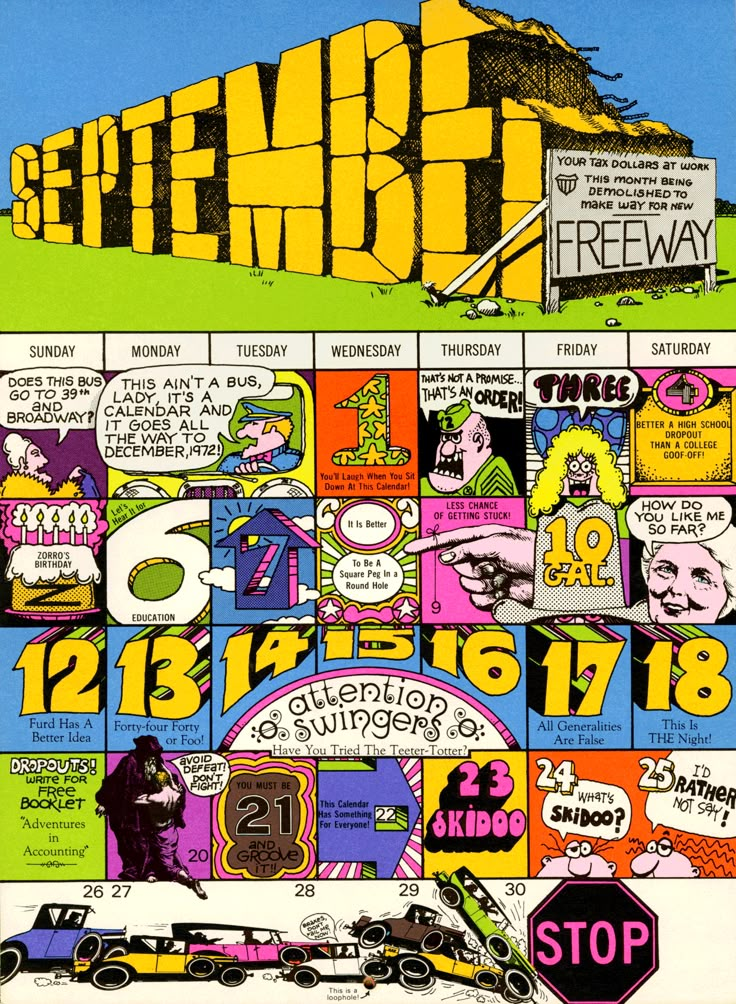David Day, a Seattle-ite, was active as a graphic designer during the 1980s and 1990s. In 2000, a fanatic vinyl obsession consumed him; he retired from design and opened a record store in his city—Jive Time Records—which is celebrating its 25th anniversary this year. “I’ve largely stepped away from commercial design,” except for custom T-shirts, posters and promotions, he notes. He also became an avid and fervid Day-Glo and Day-Glo–adjacent collector.
“I have a particular soft spot for the unique style of pop-infused psychedelia created by Hallmark and American Greetings [where R. Crumb worked] in the late 1960s and early ’70s,” Day details on his website, The Peculiar Manicule. “Behind these mod pieces’ smooth edges and sugary sentiments are some expertly executed (and wonderfully weird) examples of late Midcentury design and illustration.”
He does not have an Instagram or Facebook presence, and admits that social media would’ve been an easier, cheaper and more visible way to share his collection—but he decided to archive it online to avoid the pressure of having to post daily. Even so, he tends to add new content in fits and starts, depending on his mood and schedule.
Day’s Day-Glo focus results in a pleasantly particular uniform style (that owes a large debt to Push Pin Studios, the Pushpin Graphic and underground comics). In other words, Day’s Peculiar Manicule (a manicule is a symbol in the shape of a pointing hand) points to a wellspring of a lost (albeit derivative) treasure from a great epoch.
I never realized that Hallmark, king of middle-road American graphics, was into psychedelics. So let’s go on a Day trip.
When and why did you start collecting Hallmark calendars?
I’ve always been drawn to this kind of design. I grew up in the late ’60s and ’70s and always admired those tall, skinny, psychedelic greeting cards I saw in drugstores while my mom shopped. They were bold and strange, often with embellishments like fancy embossing, glitter, felt, intricate die-cuts, or “tipped-in” elements like feathers or other physical baubles.
In the late ’80s, after becoming a graphic designer, I really started to appreciate how clever and well-made a lot of this stuff was. One of my first memorable Hallmark discoveries was a mini-poster booklet called Ants Never Sleep, which I found in a thrift store. It looked like something out of Push Pin Studios: playful, graphic and full of surreal, nonsensical humor.
I stumbled onto the calendars in the late 1990s when I found one at a flea market, and it completely floored me. The cards and books were quirky, but the calendars were next-level weird! It still amazes me that these pieces, from a rather wholesome corporation like Hallmark, made it past the higher-ups and into stores across America. There’s something magical about a big company briefly embracing such offbeat, subversive design—and getting away with it. That one discovery sent me down a rabbit hole, and that’s when I really started collecting in earnest.
I must admit, I didn’t know these were part of the Hallmark portfolio. How did you find more?
In the very early 2000s, I started collecting more seriously. Many of my early finds came from local thrift stores, used bookstores and antique malls. Later, I turned to sites like eBay and Etsy to hunt down some harder-to-find pieces. Much of it is still surprisingly common, but a few of my favorite pieces I’ve only seen once in over 20 years of looking.
How far back and forward does your collection go?
My personal collection of ephemera (the term used to describe “disposable” art and design like greeting cards and calendars) spans from the 1920s through to modern risograph zines. But The Peculiar Manicule focuses on my favorite era: the late 1960s to early 1970s. That was the sweet spot where countercultural influence and a more commercial pop art style charm all collided in beautiful, strange ways.
Which pieces particularly stand out for their wit, style or originality?
Some of Hallmark’s “16-month” wall calendars are my favorite pieces, along with many of their small “gift books” like The Moment of Truth and How to Quit: both are filled with wild graphics, shockingly bright Day-Glo inks, inventive typography, very irreverent and weird humor, and unexpectedly sophisticated compositions that hold up as clever, highly crafted works of design.
What is the goal of your collection, and where do you think it fits in the continuum of design history?
I have a bit of a compulsive nature, so collecting is kind of in my DNA. I’ve always been drawn to things that fly under the radar—I loved grabbing vinyl in the ’90s when nobody else was paying attention. Collecting ephemera from this era was the same at first: Most of it was cheap, ignored and just waiting to be rediscovered. Most serious collectors were focusing on Fillmore and Avalon posters or underground hippy rags like The Oracle or Oz, while much of the more “groovy” or “mod” stuff flew under the radar.
I worked at The Rocket, a Seattle music publication, in the late ’80s alongside the incredible Art Chantry. He was the first person I heard use the phrase “Hallmark psychedelia.” I use it pretty literally on The Peculiar Manicule to collect all my Hallmark stuff into one section, but I think he used it more broadly—to describe the moment when psychedelic graphics converged with mainstream culture, à la Push Pin Studios, John Alcorn and Peter Max. Hallmark and American Greetings even carted hip teen-oriented lines—Hallmark Contemporary and Hi-Brows—to tap into this trend.
I originally created The Peculiar Manicule as a personal archive—a way to interact with my collection. But over time, it’s taken on a life of its own. I’ve heard from designers around the world who were inspired by something I posted, and from families of the (often uncredited) artists who created this work. They’ve told me how meaningful it is to see these pieces remembered and celebrated. That, to me, is the real goal: shining a light on these unsung heroes and preserving a moment in design history that was quietly revolutionary beneath its sugar-coated surface.
The post The Daily Heller: Psychedelics, Day-Glo, Hallmark and The Peculiar Manicule appeared first on PRINT Magazine.

